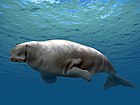
Eotheroides

| Eotheroides Temporal range: Middle - Late Eocene,
| |
|---|---|

| |
| Eotheroides sp. in Artis, Amsterdam. | |
| Scientific classification | |
| Kingdom: | |
| Phylum: | |
| Class: | |
| Order: | |
| Family: | |
| Genus: | Eotheroides Palmer, 1899
|
| Species | |
Eotheroides is an extinct genus of Eocene sirenian. It is an early member of the family Dugongidae, which includes the extant dugong. Fossils have been found from Egypt, India, and Madagascar. Eotheroides was first described by Richard Owen in 1875 under the name Eotherium, which was replaced by the current name in 1899.

Based on endocranial casts, Eotheroiodes had a smaller endocranial volume than other contemporaneous sirenians such as Protosiren. Unlike extant sirenians, Eotheroides possesses a tentorium cerebelli, which appears as a distinct transverse groove on the skull.[1]

Species

The type species, E. aegyptiacum, is known from the Lutetian Mokattam Limestone of Cairo, Egypt.[1] Another species, E. lambondrano, was recently[when?] named on the basis of material found from Middle Eocene nearshore marine deposits in the Mahajanga Basin of Madagascar. The species was named after the Malagasy word for dugong, which translates as "water bushpig". It is known from a nearly complete skull and fragments of pachyosteosclerotic (thick) ribs. Based on its age and morphology, E. lambondrano may be ancestral to E. aegyptiacum.[2] Described in 2009, E. lambondrano is the first pre-Pleistocene Cenozoic mammal named from Madagascar, being known from an 80-million-year gap in the island's fossil record.[3]

Several other species have been named, including E. babiae from India,[4] E. majus, E. clavigerum and E. sandersi from Egypt,[5][6] and E. waghapadarensis, also from India.[7] E. majus was based on a single upper molar, which was never catalogued and is now lost;[6] it has been considered a senior subjective synonym of E. aegyptiacum.[8]

Paleobiology

The teeth of Eotheroides were relatively unspecialized compared to those of extant sirenians, which are reduced as an adaptation for feeding on sea grass. The upper molars of E. lambondrano are considerably longer and wider than those of E. aegyptiacum, suggesting that they were less specialized.[1] Eotheroides is likely to have been one of the first fully aquatic sea cows. Eotheroides lambondrano was found in association with the remains of other sea cows, crocodilians, and sea turtles, which suggests that the locality is representative of a coastal or estuarine environment.[3]

References
- ^ a b c Gingerich, P. D.; Domning, D. P.; Blane, C. E.; Uhen, M. D. (1994). "Late Eocene sea cows (Mammalia, Sirenia) from Wadi Al Hitan in the Fayum Basin, Egypt". Contributions from the Museum of Paleontology. 29 (2). University of Michigan: 41–67.
- ^ Samonds, K. E.; Zalmout, I. S.; Irwin, M. T.; Krause, D. W.; Rogers, R. R.; Raharivony, L. L. (2009). "Eotheroides lambondrano, new Middle Eocene seacow (Mammalia, Sirenia) from the Mahajanga Basin, Northwestern Madagascar". Journal of Vertebrate Paleontology. 29 (4): 1233–1243. Bibcode:2009JVPal..29.1233S. doi:10.1671/039.029.0417. S2CID 59466434.
- ^ a b "Ancient Pygmy Sea Cow Discovered". Science Daily. 18 December 2009. Retrieved 18 December 2009.
- ^ Bajpai, S.; Thewissen, J. G. M.; Kapur, V. V.; Tiwari, B. N.; Sahni, A. (2006). "Eocene and Oligocene sirenians (Mammalia) from Kachchh, India". Journal of Vertebrate Paleontology. 26 (2): 400–410. doi:10.1671/0272-4634(2006)26[400:eaosmf]2.0.co;2. S2CID 86682899.
- ^ Zdansky, O. (1138). "Eotherium majus sp. n., eine neue Sirene aus dem Mitteleozän von Ägypten". Palaeobiologica. 6: 429–434.
- ^ a b Iyad S. Zalmout and Philip D. Gingerich (2012). "Late Eocene Sea Cows (Mammalia, Sirenia) From Wadi Al Hitan In The Western Desert of Fayum, Egypt". University of Michigan Papers on Paleontology. 37: 1–158. hdl:2027.42/94568.
- ^ Das, D. P.; Basu, P. K. (1994). "Study of Palaeogene marine mammals of Kachchh, Guarat". Geological Survey of India. 127 (2): 5.
- ^ Gingerich, P. D. (1992). "Marine Mammals (Cetacean and Sirenia) from the Eocene of Gebel Mokattam and Fayum, Egypt: Stratigraphy, Age, and Paleoenvironments". Contributions from the Museum of Paleontology. 30. University of Michigan: 1–84.
Further reading
- Marine Mammals: Evolutionary Biology by Annalisa Berta, James L. Sumich, and Kit M. Kovacs
- The Beginning of the Age of Mammals by Kenneth D. Rose
- Classification of Mammals by Malcolm C. McKenna and Susan K. Bell
External links
See what we do next...
OR
By submitting your email or phone number, you're giving mschf permission to send you email and/or recurring marketing texts. Data rates may apply. Text stop to cancel, help for help.
Success: You're subscribed now !

